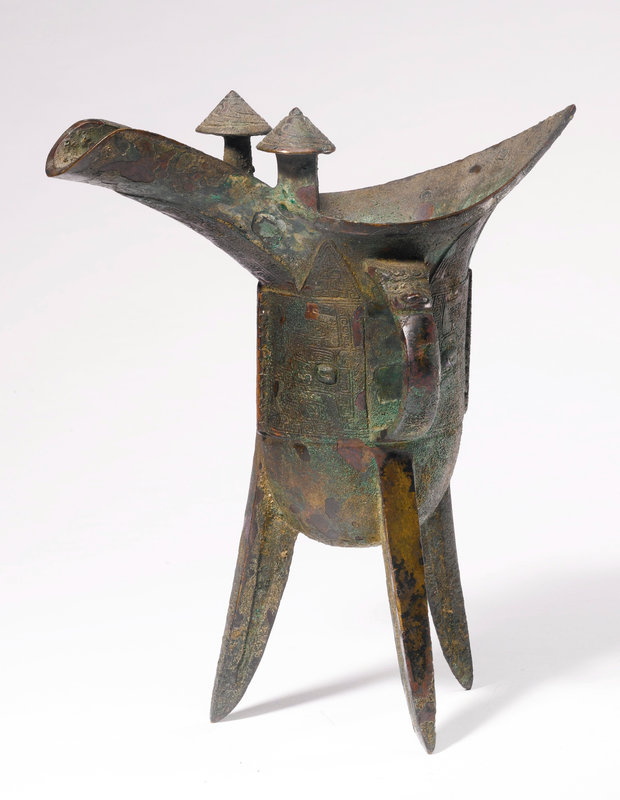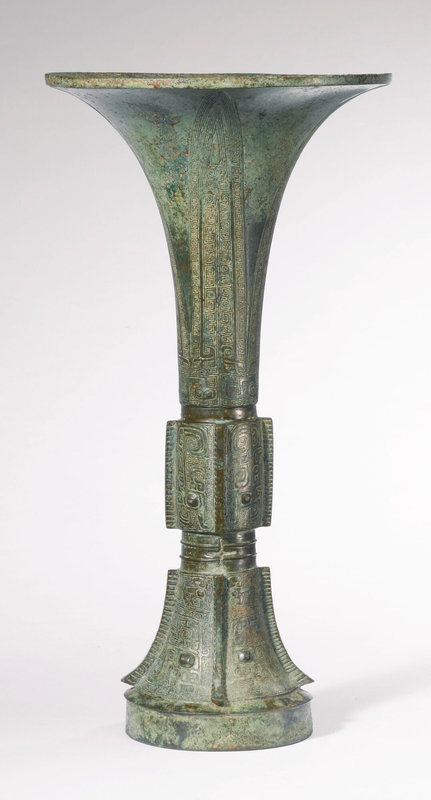Sotheby's. Fine Chinese Ceramics & Works of Art. New York 17 september 2013.
Shang dynasty bronzes sold at Sotheby's New York 17 september 2013
Lot 12. A bronze tripod ritual wine vessel (jue), Late Shang dynasty, 12th-11th century BC. Height 8 in., 20.3 cm. Lot Sold: 20,000 USD. (Estimate: 15,000 – 20,000 USD). © Sotheby's
stoutly cast, the body of deep U-form shape raised on three tapering blade supports, the sides with two taotie masks formed of detached scrolled reserves enclosing leiwen and two rectangular protuberant eyes; one centered by a narrow notched flange, the other by the bovine mask loop handle, surmounted by a band of upright triangular blades enclosing cicada in the small blades and further leiwen on the larger blades beneath the spout and rim, set with a pair of dome-capped posts with 'fire-whorl' medallions, the dark-brown patina with patches of malachite encrustation.
Provenance: Collection of Ethel Graves Sarkisian (1911-1999), Denver and thence by descent.
Lot 14. A bronze tripod ritual wine vessel (jue), Late Shang dynasty, 12th-11th century BC. Height 7 3/8 in., 18.8 cm. Lot Sold: 43,750 USD. (Estimate: 30,000 – 40,000 USD). © Sotheby's
the elongated U-shaped body supported on three slender, splayed blade legs, well-cast with a pair of taotie formed from two raised bosses for eyes and disassociated hooks and scrolls enclosing leiwen forming both the features of the mask as well as avian beaks and feathers, one divided by shallow notched flange, the other by a single pictogram comprised of two elements ge and er cast under the C-scroll handle surmounted by a bovine head, all below a row of upright triangular blades enclosing further leiwen, the rim set with two rectangular posts terminating in whorl-incised domed caps, the silvery-green patina with some patches of malachite encrustation.
Provenance: Collection of Ethel Graves Sarkisian (1911-1999), Denver and thence by descent.
Lot 17. A bronze wine vessel (gong), Late Shang dynasty, 12th-11th century BC. Height 7 3/8 in., 18.7 cm. Lot Sold: 1,925,000 USD. (Estimate: 300,000 – 500,000 USD). © Sotheby's
the oblong body set on a sloping, rectangular foot, well cast on each side with a taotie mask with raised eyes, out-curved jaws and hooked horns, the foot with two pairs of confronted kui dragons on the long sides and two pairs of confronted birds on the short sides, underneath an ascending spout, decorated by two bird-like creatures with rounded eyes, hooked beaks, three-pronged crests and elaborate tail plumes, followed by two smaller birds, all reserved on a dense leiwen ground, the massive loop handle with a powerful animal head with widely open jaw biting a bird, surmounted by shield-like horns in the form of a pair of confronted dragons, all divided by heavy flanges, an inscription of one clan sign and two characters fu ding to the base of interior, the surface with a dark silvery-green patina.
Provenance: Acquired from Professor Alfred Salmony, 1953.
Note: Bronze vessels of this rare form are known both with oval and rectangular cross sections. It is notable that in general, bronze vessels of rectangular cross sections are much rarer than those of oval or round cross sections. Therefore, the present rectagular gong vessel is among the rarest forms of Chinese archaic bronzes. This form is not only celebrated for its rarity but is also remarkable for its intrinsic beauty. The rectangular profile accentuates the powerful silhouette of the vessel which is further enhanced by the heavy, toothed flanges.
Rectangular gong vessels of this type, but of slightly different design, include one formerly in the von Lochow collection, illustrated in Robert W. Bagley, Shang Ritual Bronzes in the Arthur M. Sackler Collection, Washington, D.C. 1987, p. 299; one from the Seattle Art Museum illustrated in Early Chinese Metalwork in the Collection of the Seattle Art Museum, Seattle, 1989, no. 8; another with a cover in the Nagao Art Museum, Tokyo illustrated in Jessica Rawson, Western Zhou Ritual Bronzes from the Arthur M. Sackler Collection, Washington, D.C. 1990, p. 698; a fang gong vessel with a cover in the Sen-oku Hakuko Kan is illustrated in Sen-oku Hakuko Kan Sumitomo Collection, Tokyo, 2002, p. 92, no. 108; the fifth covered fang gong formerly in the Qing Court Collection, is now in the Idemitsu Museum, included in Sugimura Yuzo, Chinese Archaic Bronzes, Tokyo, 1966, pp. 64-73; compare also a large fang gong vessel with cover, excavated in 1976 from Fufeng county, Shaanxi province and illustrated in Xu Tianjin, Fine Western Zhou's Bronzes Unearthed from Zhouyuan, Beijing, 2002, pp. 94-107, no. 6.
Gong originated in the second phase of the Anyang period and rapidly replaced the animal-shaped zun vessels. According to Jessica Rawson in Western Zhou Ritual Bronzes from the Arthur M. Sackler Collection, "vessels wholly or partly shaped like animals did not lend themselves to the compartmented shapes that make up the standard repertory of the Anyang casters" (pp. 695-697). Gong vessels of this kind satisfy both the interest in the realistic representation of creatures and the convention of dividing surface decor into arbitrary compartments.
This piece was acquired from Alfred Salmony, the renowned art historian in Far Eastern arts who served as curator of the Cologne Museum of the Far East from 1920 to 1933. In 1934, he immigrated to the U.S. and became the Oriental Art specialist at the Institute of Fine Arts, New York University. In New York, Dr. Salmony helped C.T. Loo on several catalogues including the ground-breaking Sino-Siberian Art in the Collection of C.T. Loo.
Lot 20. A bronze tripod wine vessel (jia), Late Shang-Early Western Zhou dynasty, 12th-11th century BC. Height 10 3/4 in., 27.3 cm. Lot Sold: 161,000 USD. (Estimate: 40,000 - 60,000 USD). © Sotheby's
the tri-lobed body resting on three columnar legs, simply decorated with double bow-string bands framing each section, further decorated by a single bow-string band around the base of the trumpet-shaped neck interrupted by a loop handle issuing from a bovine head, a three-character inscription cast on the body underneath the loop, the first a pictogram, followed by Fu Yi (Father Yi), the dark silvery-green patina with some encrustation.
Provenance: Collection of Horatio Seymour Rubens prior to 1950.
An old Japanese collection before the 1970s and thence by descent.
Literature: Chen Mengjia, In Shu seidoki bunrui zuroku (A Corpus of Chinese Bronzes in American Collections), Tokyo, 1977, no. A323.
Yan Yiping, Jinwen Zongji, Taipei, 1983, no. 4313.
Institute of Archeology, Chinese Academy of Social Science, Yinzhou jinwen jicheng, 1984, no. 9206.
Wu Zhenfeng, Shangzhou qingtongqi mingwen ji tuxiang jicheng (Compendium of Shang and Zhou Bronze Inscriptions and Images), Shanghai, 2012, p. 131, no. 11032.
Note: The present jia vessel is quite unusual in that the umbrella-shaped posts are absent from its rim. The inscription underneath the loop handle comprises one clan sign and two characters 'father yi'. A very similar jia vessel was sold at Christie's New York, 22nd March 2007, lot. 241. Another similar bronze jia vessel unearthed from Guojiazhuang village, Anyang city, Henan province is illustrated in Yinxu xinchutu qingtongqi (Ritual Bronzes Recently Excavated in Yinxu), Kunming, 2008, p. 266, no. 133.
Lot 35. A bronze ritual wine vessel (gu), Late Shang dynasty, 13th-13th century BC. Height 12 3/8 in., 31.3 cm. Lot Sold: 245,000 USD. (Estimate: 60,000 - 80,000 USD). © Sotheby's
of slender, waisted form, crisply cast around the mid-section and splayed foot with pairs of taotie masks with raised eyes on a fine leiwen ground, centered by notched flanges and divided by a pair of bowstrings interrupted by two cruciform apertures, the tall flared neck encircled at the base by a narrow band of hooked scroll serpents with protuberant eyes all below four upright triangular blades enclosing parallel hooked lines and further leiwen, the patina of silvery green color with areas of light encrustation, the base interior with a three-character inscription, Ya Mu Shou.
Provenance: Collection of Captain S. N. Ferris Luboshez (1896-1984), Falls Church, Virginia.
Sotheby's London, 29th March 1977, lot 171.
Sotheby's London, 15th April 1980, lot 18.
Christie's London, 16th December 1981, lot 314.
Collection of Dr. Ip Yee.
Sotheby's Hong Kong, 19th November 1984, lot 2.
Literature: Wang Tao and Liu Yu, A Selection of Early Chinese Bronzes with Inscriptions from Sotheby's and Christie's Sales, Shanghai, 2005, no. 225.
Chen Mengjia, A Classified Catalogue of Bronzes of the Yin and Zhou Dynasties, Tokyo, 1977, no. A481 (R149).
Hayashi Minao, Conspectus of Yin-Zhou Bronzes, Tokyo, 1984, vol. 1, Gu, no. 127.
Sold at auction in our London rooms 29th March, 1977, lot 171, the gu was offered as one of a selection of seventeen pieces from the famous collection of Captain and Mrs. S. N. Ferris Luboshez. A lawyer and inventor who held numerous patents, Luboshez served in the US Navy during World War II and ended his tour of duty as a Central Field Commissioner based primarily in Shanghai. It was during his four years living in China from roughly 1945-1949 that he collected a large group of early ceramics from the Han and Tang dynasties as well as Shang and Zhou dynasty bronzes. It was through his official position that he gained access to many fine pieces which he purchased in Shanghai, Beijing and on frequent trips to Japan. For further reading on Luboshez see Jane Tilley Griffen, 'The Luboshez Collection', Arts of Asia, Vol. 2, No. 4, 1927.
The vessel was also in the collection of Dr. Ip Yee who was a legendary figure in the art circles of Hong Kong. He was interested in a wide range of art and formed a vast and important collection. He generously donated many objects to Chinese museums, and, after his death, his collection was auctioned by Sotheby's in Hong Kong in 1984, to benefit numerous children's charities and museums. He was instrumental in the organizations of several seminal exhibitions such as the Chinese Bamboo Carving (HK Museum of Art, 1978), An Anthology of Chinese Ceramics (HK Museum of Art, 1980) and Chinese Jade Carving (HK Museum of Art, 1983).

/https%3A%2F%2Fprofilepics.canalblog.com%2Fprofilepics%2F1%2F0%2F100183.jpg)
/https%3A%2F%2Fstorage.canalblog.com%2F03%2F02%2F119589%2F96711876_o.jpg)
/https%3A%2F%2Fstorage.canalblog.com%2F11%2F31%2F119589%2F94773502_o.jpg)
/https%3A%2F%2Fstorage.canalblog.com%2F20%2F83%2F119589%2F94772815_o.jpg)
/https%3A%2F%2Fstorage.canalblog.com%2F26%2F72%2F119589%2F75604929_o.jpg)
/https%3A%2F%2Fstorage.canalblog.com%2F59%2F60%2F119589%2F26458628_o.jpg)







/image%2F1371349%2F20240406%2Fob_b23648_434058570-1644317966338216-88086167391.jpg)
/image%2F1371349%2F20240403%2Fob_6d5ae7_dp-28103-001.jpg)
/image%2F1371349%2F20240229%2Fob_8f31f9_431013694-1625286614908018-33034430839.jpg)
/http%3A%2F%2Fstorage.canalblog.com%2F79%2F20%2F119589%2F129837997_o.jpg)